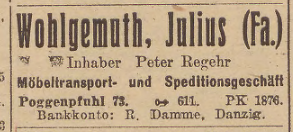Upward mobility in West Prussia
In the first half of the 19th century, there was little social or geographical mobility. By the 1880s, technological and social change opened broader horizons for the younger generation of Jewish men and women throughout all areas of Jewish settlement. In West Prussia, young men left their ancestral towns to seek opportunities in the surrounding area. Isaak Wohlgemuth, his older brother Julius and another relative all left Stargardt around 1890 to resettle in the nearby larger city of Elbing.
Isaak established himself in the milling business and started a family there. In 1898, he married Betty Katz from the Pomeranian coastal city of Kolberg, where he probably traveled for business. Betty was the daughter of Louis Katz, also a merchant, from Kolberg. Elly was Isaak and Betty’s first daughter, born in Elbing in 1901. A few years after that, they relocated again to the more cosmopolitan port city of Danzig, where another daughter, Hilde, was born in 1906.
The family prospered in Danzig. Isaak and his brother Julius were co-owners of a freight and moving business located in the city’s old port district. The Wohlgemuths attended a liberal synagogue congregation and participated in the city's enlightened Jewish cultural scene. They appreciated the benefits of assimilating into the broader German society. They viewed with disdain what they called Ostjuden—orthodox Jews from the Russian Pale who passed through or resettled in Danzig.
Yet these unwashed masses were also his company’s clientele, so Isaak still straddled two worlds. In 1912, the brothers decided to cash in and sold the business to a German, Peter Regehr, who continued to operate the company under the Julius Wohlgemuth name all the way to the end of the Nazi period.

